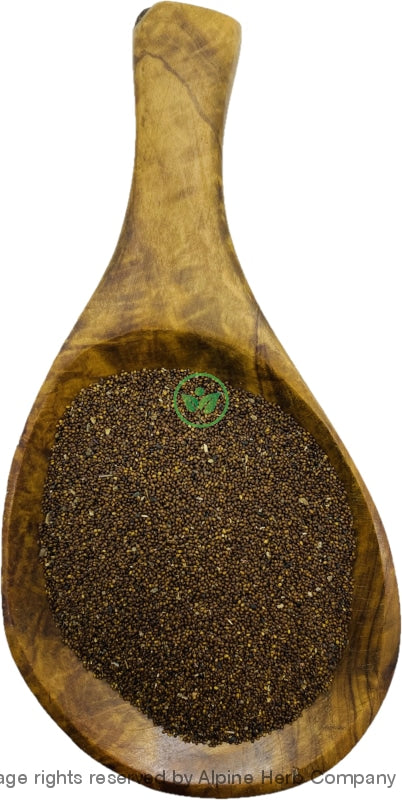Tulsi Seed Whole Alpine Herb Company Inc.
$ 10,99 $ 6,59
Botanical Name: Ocimum sanctum
Common Name:
- English: Tulsi, Holy Basil Seed, Tulsi Seed
- Ayurvedic: Tulasi, Surasaa, Surasa, Bhuutaghni, Suravalli, Sulabhaa, Manjarikaa.
- Unani: Tulasi.
- Siddha: Tulasi, Nalla-Tulasi.
- Also, known as: Tamole, Thulasi, Tjlsi, Tulashi, Tulasi, Thiru Theezai, Tulasa, Tulas, Tulusa, Bana Tulasi, Badrooj, Basilic Des Moines, Bazsalikom Levél, Daun Lampes, Monk’s Basil, Peihan, Rayhhan, Reihan, Sacred Basil, Garden Balsam, Green Tulsi, Holy Basil, Huong Nhu TiIa, Jagu Lu Myah, Kamimebouki, Kaphrao, Kaprao, Kemangi, Kemangi Laki, Kra Phrao, Lampas, Saling-Kugon, Saling-Kugon Ma, Selaseh Puteh, Solasi, Sulasi, Sursa, Bahumanjari, Devadundubhi, Apet-raakshasi, Shuulaghni, Graamya, Sulabhaa, Shree Tulasi, Vishnu Tulasi
Origin: India
Harvested: Wild
Parts Used: Seed
General Information:
A rich heritage of knowledge on preventive and curative medicines was available in ancient scholastic work included in the Atharvaveda (an Indian religious book), Ayurveda (Indian traditional system of medicine) and so on. An estimate suggests that about 13000 plant species worldwide are known to have been used as drugs. Plant-based natural constituents can be derived from any part of the plant like bark, leaves, flowers, roots, fruits, seeds and so on, that is any part of the plant may contain active components. The beneficial medicinal effects of plant materials typically result from the combinations of secondary products present in the plant.
Ocimum sanctum has been used for thousands of years in Ayurveda for its diverse healing properties. Tulsi, the Queen of herbs, the legendary ‘Incomparable one’ of India, is one of the holiest and most cherished of the many healing and healthy giving herbs of the orient. The sacred basil, Tulsi, is renowned for its religious and spiritual sanctity, as well as for its important role in the traditional Ayurvedic and Unani system of holistic health and herbal medicine of the East. It is mentioned by Charaka in the Charaka Samhita; an Ayurvedic text.
For more than 3,000 years holy basil has been honored as one of India’s most sacred and powerful plants. One of the oldest and most sophisticated systems of medicine in the world, Ayurveda, reveres this plant. Sanskrit, Tulsi means “beyond compare.” It is also referred to as the queen of herbs, and Mother Nature of medicine. Different types of holy basil: 1) Rama Tulsi (Ocimum sanctum) has green leaves; it is the most commonly cultivated holy basil and the easiest to find for purchase. 2) Krishna Tulsi (Ocimum sanctum) is the same species as Rama Tulsi but has leaves that are more purple in color.
Ocimum sanctum is an erect, much branched sub-shrub 30-60 cm tall, with simple opposite green or purple leaves that are strongly scented and hairy stems. Leaves have petiole and are ovate, up to 5 cm long, usually somewhat toothed. Flowers are purplish in elongate racemes in close whorls. Tulsi is an aromatic shrub in the basil family Lamiaceae
Hindu has been worshipping the Tulsi herb morning and evening since the past 5000 years. Due to its effective benefits, it is not known in India, but also known in all over the world. The meaning of the word Tulsi is “the incomparable Plant”. Tulsi is the Sanskrit name of the Holy Basil plant.
How to use:
Hot Infusion:
The basic method for dried herbs and flower is, take 2-3 tablespoons of dried herb in a cup or teapot. Pour hot water over it and cover it with lid for 10-30 minutes. Hot water is needed to draw out the antioxidants, enzymes, vitamins, flavonoids, and volatile oils from the botanicals. Strain and squeeze out as much as liquid as possible and enjoy!
Tips:
- You can sweeten your herbal tea with a bit of honey, natural fruit juice, stevia leaves powder and or licorice root powder.
- You can make ice cubes or pops by freezing tea in ice trays or pop molds.
Precautions:
You should consult with a qualified healthcare practitioner before using any herbal products, particularly if you are pregnant, nursing, or on any medications.
All information on this website is for educational purposes ONLY.
This information has not been evaluated by Health Canada.
This information is NOT intended to diagnose, treat, cure, or prevent any disease.
| Unit Size | 100g, 200g, 400g, 1kg |
|---|
Prompt shipping and expert packing
Thanks to our longstanding association with UPS FedEx DHL as well as other leading global carriers, we can offer a variety shipping options. Our warehouse staff is highly trained and will be able to pack your goods in accordance with our precise and exact specifications. Your items will go through an exhaustive examination before they will be securely packaged before being delivered. We ship to hundreds of thousands of customers daily in different countries. This is a sign of our determination to become the largest online retailer worldwide. Warehouses and distribution centers are located throughout Europe as well as in the USA.
Note that orders containing multiple items are processed according to the particular item.
We will thoroughly inspect all items ordered before shipping. Most orders are shipped within 48 hours. The delivery time will be between 3 and 7 working days.
Returns
The stock market is always changing. It's not entirely managed by us since we're involved with several entities, including the factory and the storage. Therefore, the actual inventory could fluctuate at any moment. Please be aware that it is possible that your order could be out of stock after you've placed your order.
Our policy lasts for 30 days. If it's been more than 30 days since the date you purchased your item We're sorry to say that we can't offer you a full exchange or refund.
You can only return a product if it is unused and still in the same state as when you received it. The item should be in the original packaging.


































